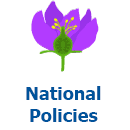In Zambia, investment in agricultural extension with a focus on gender equity and nutrition outcomes has been increasing, and in the last decade, several organizations have replicated projects in different geographical areas. However, with persistent high prevalence of malnutrition and micronutrient deficiencies still being recorded especially among children below the age of five, it is either these initiatives have little impact on reducing malnutrition, they are not sufficient, the correct programs are not being implemented, and/or the methods used to measure the impact may be inappropriate.
 Every country has developed, formulated, and decreed national policies related to rural advisory services. Find some examples here. If you are looking for a national policy from a specific country, please use the search function, selecting the category “National policies” and the tag for the country.
Every country has developed, formulated, and decreed national policies related to rural advisory services. Find some examples here. If you are looking for a national policy from a specific country, please use the search function, selecting the category “National policies” and the tag for the country.
Wednesday, 25 April 2018 16:42
Analysis of Indicators and Measurement Tools Used in Zambia to Assess Impact of Agricultural Extension Programs on Gender Equity and Nutrition Outcomes
Written by Ingrid OliveiraDownload here5450 times downloaded
Published in
Recommendations
Tagged under
Latest from Ingrid Oliveira
- Sustainable Undernutrition Reduction in Ethiopia: Training manual for Health and Agriculture Development Armies
- What Every Extension Worker Should Know - Core Competency Handbook
- Sustainable Nutrition Manual Part 3: Healthy Designs
- Sustainable Nutrition Manual Part 2: Healthy Environments
- Sustainable Nutrition Manual Part 1: Healthy Humans


